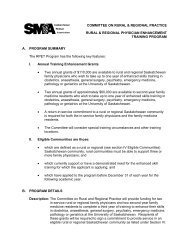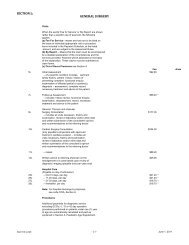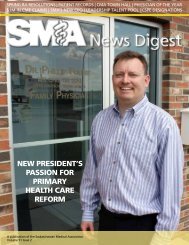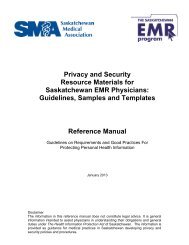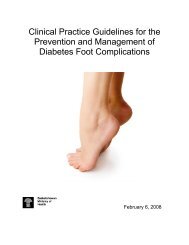Get ready for Clinical Practice Redesign - Saskatchewan Medical ...
Get ready for Clinical Practice Redesign - Saskatchewan Medical ...
Get ready for Clinical Practice Redesign - Saskatchewan Medical ...
You also want an ePaper? Increase the reach of your titles
YUMPU automatically turns print PDFs into web optimized ePapers that Google loves.
health care<br />
“No state or province that I’m aware of in the<br />
world has attempted it on this scale.”<br />
front lines - in this case, health care workers, patients and<br />
their families.<br />
Florizone admits he was skeptical until he participated in<br />
a workshop at Seattle’s Virginia Mason <strong>Medical</strong> Centre in<br />
2004.<br />
“It’s going to take a lot of leadership to be able to convince<br />
people this isn’t a fad,” Florizone said. “There’s only<br />
one way to convince the skeptic and that’s the way I was<br />
convinced - let’s do it.”<br />
It is a mistake to think health care is so different from<br />
other industries that it can’t use the same solutions manufacturers<br />
have al<strong>ready</strong> found to similar problems, Florizone<br />
said.<br />
“The old way of cost-cutting was absolutely wrong-headed,”<br />
he said. “I realized <strong>for</strong> the first time why we were so<br />
mistaken in the ‘80s and ‘90s when we were cutting budgets<br />
and ending up with poor service at the end of the<br />
day.”<br />
Deciding what to tackle is another key component of lean<br />
management. Florizone said an organization needs to<br />
pick just a couple of top priorities and focus intensely on<br />
them be<strong>for</strong>e moving on to the rest of its wish list. “If everything’s<br />
a priority, nothing’s a priority.”<br />
The government has organized lean’s provincial rollout<br />
into two phases.<br />
The planning phase in lean management is usually called<br />
hoshin kanri, a Japanese phrase. The government is calling<br />
it ‘strategy deployment.’<br />
Unlike current strategic planning, high-level executives<br />
will run their proposed priorities be<strong>for</strong>e teams of lowerlevel<br />
managers and front-line workers, and then consider<br />
their feedback be<strong>for</strong>e proceeding.<br />
12 Spring 2012 SMA News Digest<br />
-Dan Florizone, Deputy Minister of Health<br />
Phase two will take several years and involves building up<br />
local expertise and getting more than 43,000 workers in<br />
the province’s health regions, the <strong>Saskatchewan</strong> Cancer<br />
Agency, the Health Quality Council and the Health Ministry<br />
thinking like a synchronized lean machine: Identify<br />
waste, test a possible fix, evaluate the outcome and repeat.<br />
The cycle can, and should, go on <strong>for</strong>ever.<br />
To do this, the province needs a lean expert, or sensei, to<br />
lead it. This fall, the <strong>Saskatchewan</strong> Association of Health<br />
Organizations issued two requests <strong>for</strong> proposals - one<br />
contract <strong>for</strong> about six months of lean leadership to do the<br />
first phase of planning - hoshin kanri - and a longer-term<br />
contract to help roll out the lean system.<br />
SAHO Past President and CEO Susan Antosh said the first<br />
contract was awarded in October to American consultants<br />
John Black and Associates. The second contract has not<br />
yet been awarded.<br />
The consultants won’t just teach and run, she said - the<br />
region wants to build a long-term relationship with someone<br />
who has the experience and knowledge to guide them<br />
through years of significant cultural change.<br />
The SMA is currently in discussions with the provincial<br />
government regarding lean implementation and the role<br />
<strong>for</strong> physicians in the trans<strong>for</strong>mation process.




